Bioscience 1 Assessment 2 (Part B): Short Answer Questions on Health
VerifiedAdded on 2021/05/31
|7
|1367
|57
Homework Assignment
AI Summary
This assignment, a solution to Bioscience 1 Assessment 2 (Part B), addresses key concepts in biology and human health. It includes a review of referencing and paraphrasing, along with short-answer questions focusing on body temperature regulation by the skin, the role of cholesterol and lipoproteins in cardiovascular health, and the importance of Vitamin B9 (folate) and iron. The student's answers demonstrate an understanding of these topics, including dietary recommendations for optimal health and the consequences of nutrient deficiencies. References are provided, demonstrating the importance of academic integrity. This document serves as a valuable resource for students studying similar topics, providing insights into answering questions on these subjects and understanding the importance of referencing and paraphrasing in academic work. The assignment covers topics related to physiology, nutrition, and disease, making it relevant to students in health-related fields.
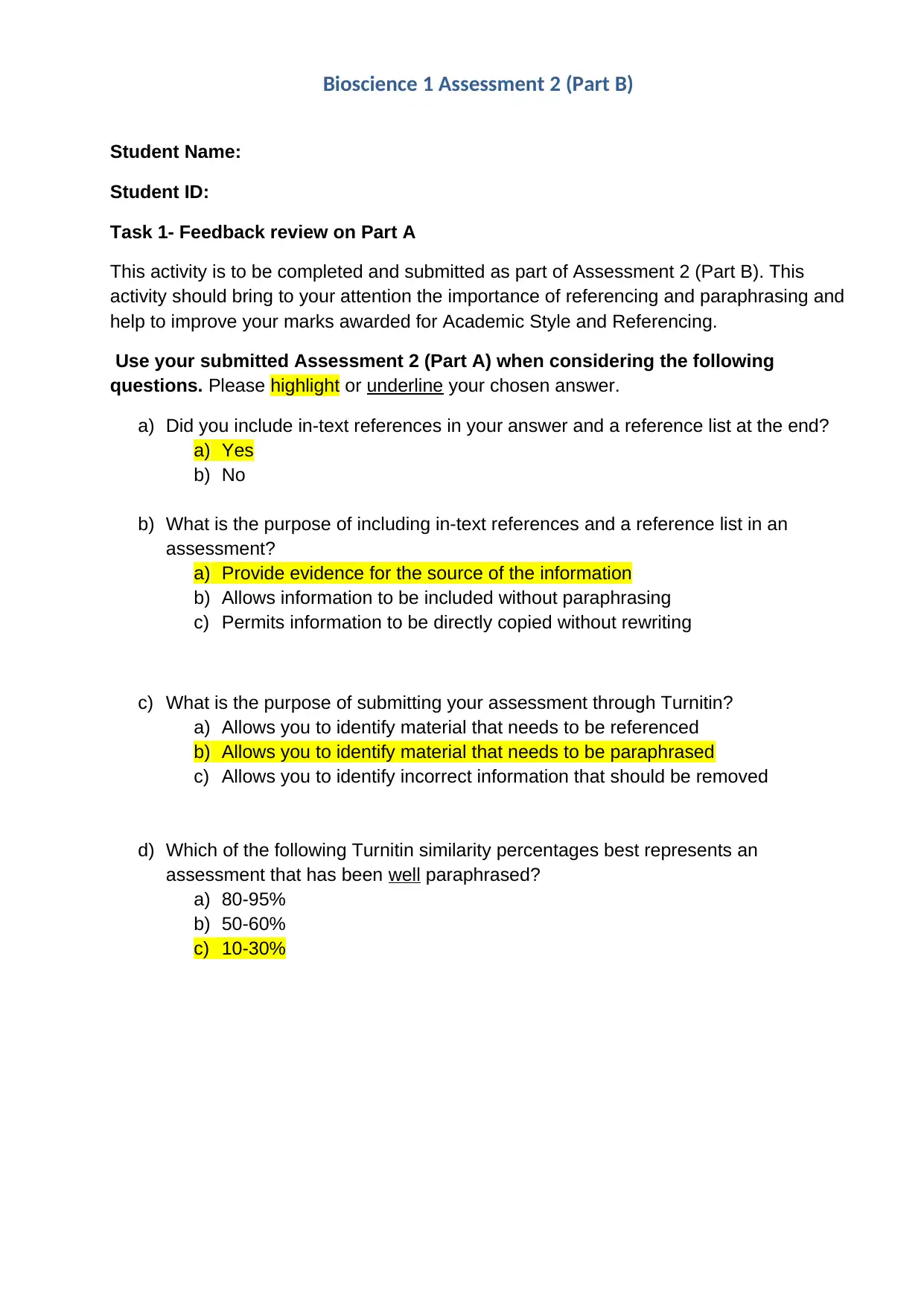
Bioscience 1 Assessment 2 (Part B)
Student Name:
Student ID:
Task 1- Feedback review on Part A
This activity is to be completed and submitted as part of Assessment 2 (Part B). This
activity should bring to your attention the importance of referencing and paraphrasing and
help to improve your marks awarded for Academic Style and Referencing.
Use your submitted Assessment 2 (Part A) when considering the following
questions. Please highlight or underline your chosen answer.
a) Did you include in-text references in your answer and a reference list at the end?
a) Yes
b) No
b) What is the purpose of including in-text references and a reference list in an
assessment?
a) Provide evidence for the source of the information
b) Allows information to be included without paraphrasing
c) Permits information to be directly copied without rewriting
c) What is the purpose of submitting your assessment through Turnitin?
a) Allows you to identify material that needs to be referenced
b) Allows you to identify material that needs to be paraphrased
c) Allows you to identify incorrect information that should be removed
d) Which of the following Turnitin similarity percentages best represents an
assessment that has been well paraphrased?
a) 80-95%
b) 50-60%
c) 10-30%
Student Name:
Student ID:
Task 1- Feedback review on Part A
This activity is to be completed and submitted as part of Assessment 2 (Part B). This
activity should bring to your attention the importance of referencing and paraphrasing and
help to improve your marks awarded for Academic Style and Referencing.
Use your submitted Assessment 2 (Part A) when considering the following
questions. Please highlight or underline your chosen answer.
a) Did you include in-text references in your answer and a reference list at the end?
a) Yes
b) No
b) What is the purpose of including in-text references and a reference list in an
assessment?
a) Provide evidence for the source of the information
b) Allows information to be included without paraphrasing
c) Permits information to be directly copied without rewriting
c) What is the purpose of submitting your assessment through Turnitin?
a) Allows you to identify material that needs to be referenced
b) Allows you to identify material that needs to be paraphrased
c) Allows you to identify incorrect information that should be removed
d) Which of the following Turnitin similarity percentages best represents an
assessment that has been well paraphrased?
a) 80-95%
b) 50-60%
c) 10-30%
Paraphrase This Document
Need a fresh take? Get an instant paraphrase of this document with our AI Paraphraser
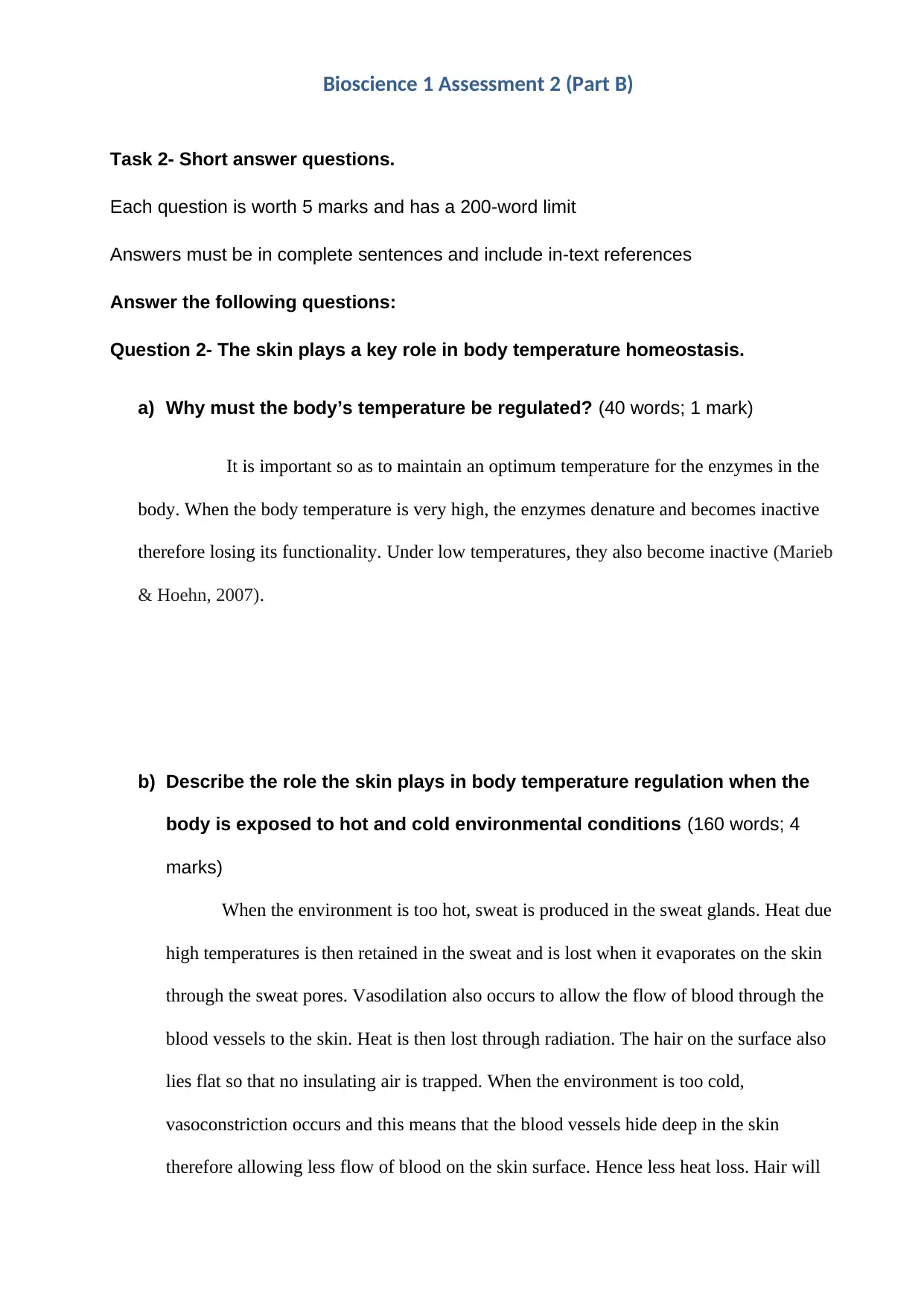
Bioscience 1 Assessment 2 (Part B)
Task 2- Short answer questions.
Each question is worth 5 marks and has a 200-word limit
Answers must be in complete sentences and include in-text references
Answer the following questions:
Question 2- The skin plays a key role in body temperature homeostasis.
a) Why must the body’s temperature be regulated? (40 words; 1 mark)
It is important so as to maintain an optimum temperature for the enzymes in the
body. When the body temperature is very high, the enzymes denature and becomes inactive
therefore losing its functionality. Under low temperatures, they also become inactive (Marieb
& Hoehn, 2007).
b) Describe the role the skin plays in body temperature regulation when the
body is exposed to hot and cold environmental conditions (160 words; 4
marks)
When the environment is too hot, sweat is produced in the sweat glands. Heat due
high temperatures is then retained in the sweat and is lost when it evaporates on the skin
through the sweat pores. Vasodilation also occurs to allow the flow of blood through the
blood vessels to the skin. Heat is then lost through radiation. The hair on the surface also
lies flat so that no insulating air is trapped. When the environment is too cold,
vasoconstriction occurs and this means that the blood vessels hide deep in the skin
therefore allowing less flow of blood on the skin surface. Hence less heat loss. Hair will
Task 2- Short answer questions.
Each question is worth 5 marks and has a 200-word limit
Answers must be in complete sentences and include in-text references
Answer the following questions:
Question 2- The skin plays a key role in body temperature homeostasis.
a) Why must the body’s temperature be regulated? (40 words; 1 mark)
It is important so as to maintain an optimum temperature for the enzymes in the
body. When the body temperature is very high, the enzymes denature and becomes inactive
therefore losing its functionality. Under low temperatures, they also become inactive (Marieb
& Hoehn, 2007).
b) Describe the role the skin plays in body temperature regulation when the
body is exposed to hot and cold environmental conditions (160 words; 4
marks)
When the environment is too hot, sweat is produced in the sweat glands. Heat due
high temperatures is then retained in the sweat and is lost when it evaporates on the skin
through the sweat pores. Vasodilation also occurs to allow the flow of blood through the
blood vessels to the skin. Heat is then lost through radiation. The hair on the surface also
lies flat so that no insulating air is trapped. When the environment is too cold,
vasoconstriction occurs and this means that the blood vessels hide deep in the skin
therefore allowing less flow of blood on the skin surface. Hence less heat loss. Hair will
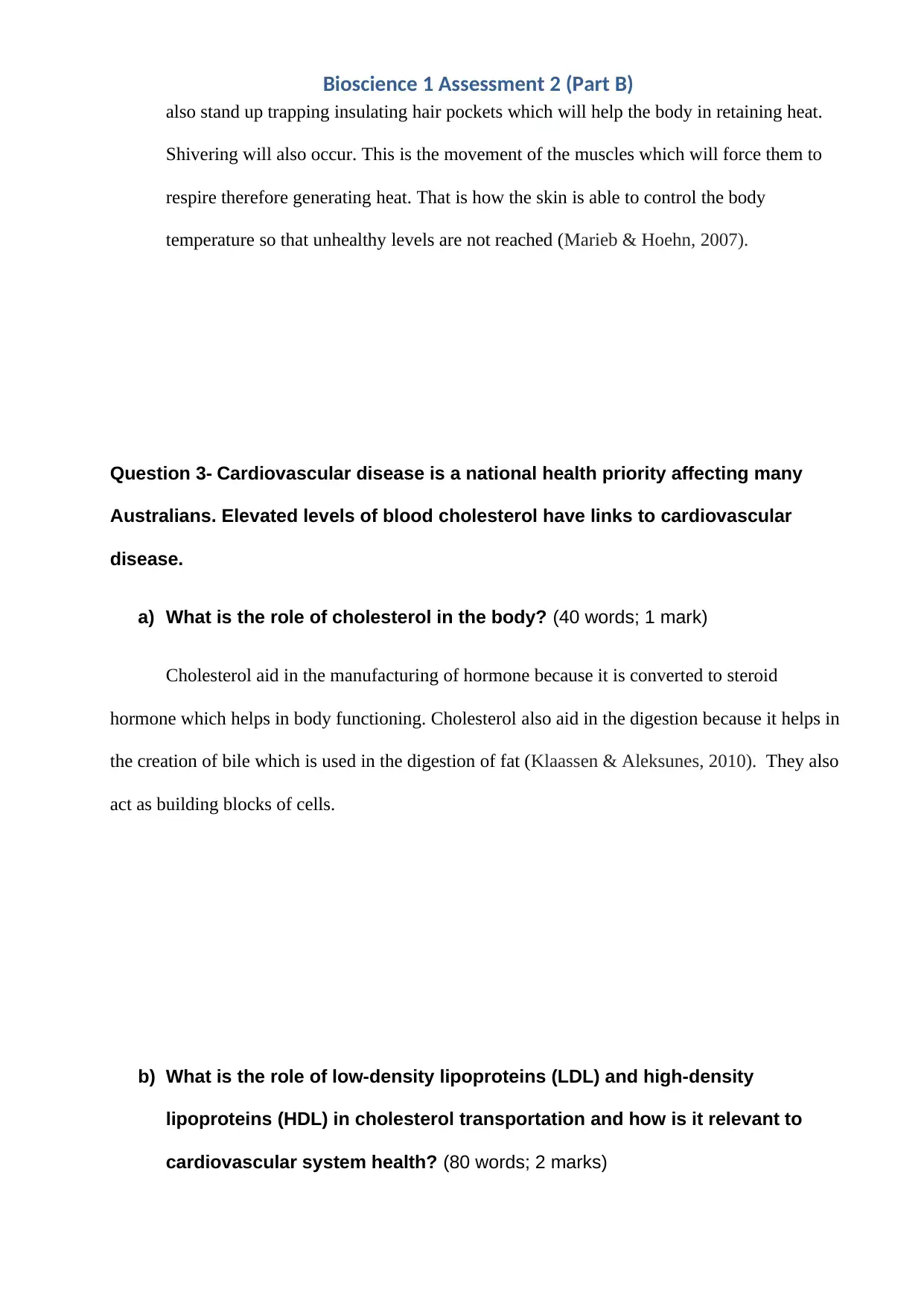
Bioscience 1 Assessment 2 (Part B)
also stand up trapping insulating hair pockets which will help the body in retaining heat.
Shivering will also occur. This is the movement of the muscles which will force them to
respire therefore generating heat. That is how the skin is able to control the body
temperature so that unhealthy levels are not reached (Marieb & Hoehn, 2007).
Question 3- Cardiovascular disease is a national health priority affecting many
Australians. Elevated levels of blood cholesterol have links to cardiovascular
disease.
a) What is the role of cholesterol in the body? (40 words; 1 mark)
Cholesterol aid in the manufacturing of hormone because it is converted to steroid
hormone which helps in body functioning. Cholesterol also aid in the digestion because it helps in
the creation of bile which is used in the digestion of fat (Klaassen & Aleksunes, 2010). They also
act as building blocks of cells.
b) What is the role of low-density lipoproteins (LDL) and high-density
lipoproteins (HDL) in cholesterol transportation and how is it relevant to
cardiovascular system health? (80 words; 2 marks)
also stand up trapping insulating hair pockets which will help the body in retaining heat.
Shivering will also occur. This is the movement of the muscles which will force them to
respire therefore generating heat. That is how the skin is able to control the body
temperature so that unhealthy levels are not reached (Marieb & Hoehn, 2007).
Question 3- Cardiovascular disease is a national health priority affecting many
Australians. Elevated levels of blood cholesterol have links to cardiovascular
disease.
a) What is the role of cholesterol in the body? (40 words; 1 mark)
Cholesterol aid in the manufacturing of hormone because it is converted to steroid
hormone which helps in body functioning. Cholesterol also aid in the digestion because it helps in
the creation of bile which is used in the digestion of fat (Klaassen & Aleksunes, 2010). They also
act as building blocks of cells.
b) What is the role of low-density lipoproteins (LDL) and high-density
lipoproteins (HDL) in cholesterol transportation and how is it relevant to
cardiovascular system health? (80 words; 2 marks)
⊘ This is a preview!⊘
Do you want full access?
Subscribe today to unlock all pages.

Trusted by 1+ million students worldwide
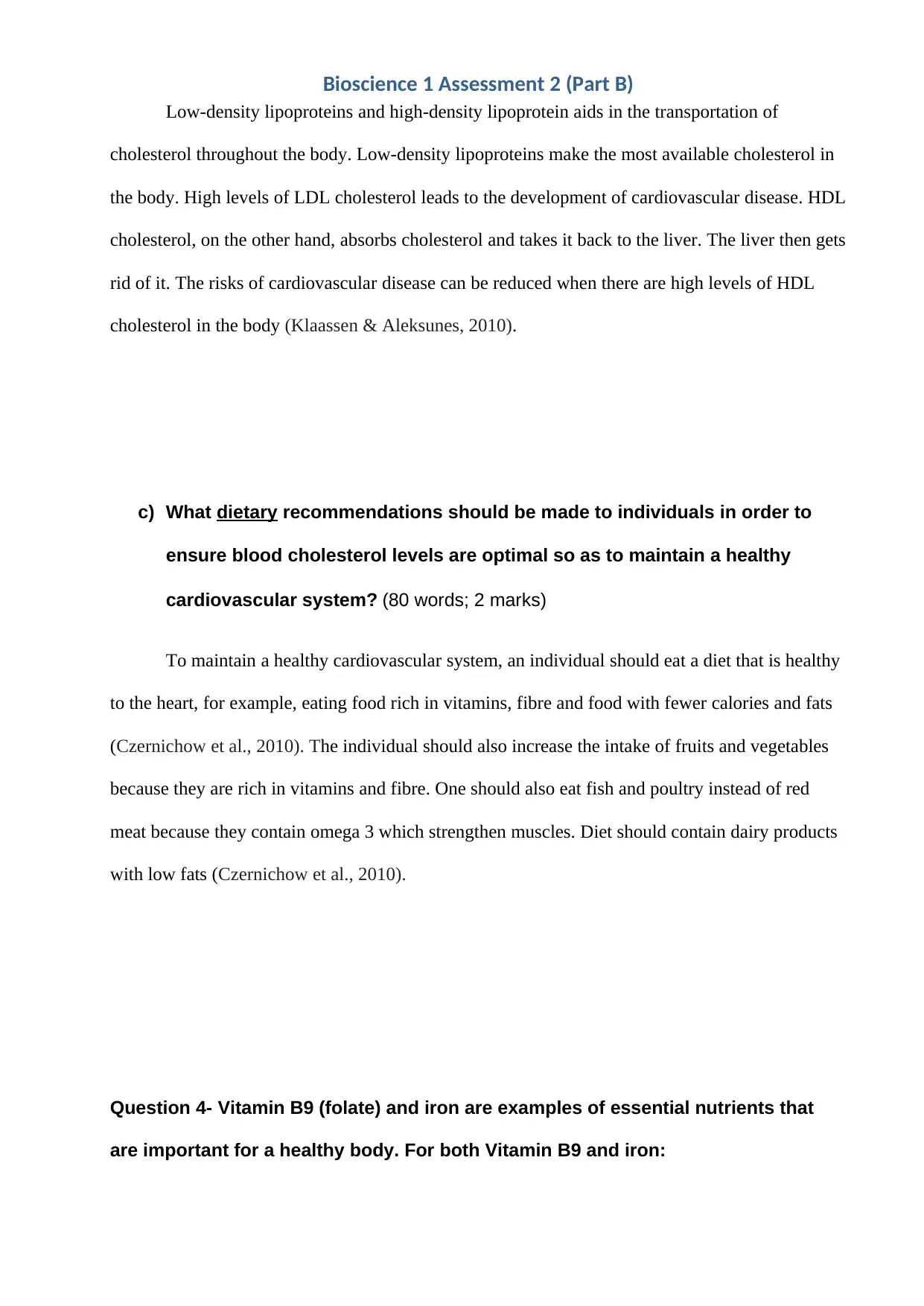
Bioscience 1 Assessment 2 (Part B)
Low-density lipoproteins and high-density lipoprotein aids in the transportation of
cholesterol throughout the body. Low-density lipoproteins make the most available cholesterol in
the body. High levels of LDL cholesterol leads to the development of cardiovascular disease. HDL
cholesterol, on the other hand, absorbs cholesterol and takes it back to the liver. The liver then gets
rid of it. The risks of cardiovascular disease can be reduced when there are high levels of HDL
cholesterol in the body (Klaassen & Aleksunes, 2010).
c) What dietary recommendations should be made to individuals in order to
ensure blood cholesterol levels are optimal so as to maintain a healthy
cardiovascular system? (80 words; 2 marks)
To maintain a healthy cardiovascular system, an individual should eat a diet that is healthy
to the heart, for example, eating food rich in vitamins, fibre and food with fewer calories and fats
(Czernichow et al., 2010). The individual should also increase the intake of fruits and vegetables
because they are rich in vitamins and fibre. One should also eat fish and poultry instead of red
meat because they contain omega 3 which strengthen muscles. Diet should contain dairy products
with low fats (Czernichow et al., 2010).
Question 4- Vitamin B9 (folate) and iron are examples of essential nutrients that
are important for a healthy body. For both Vitamin B9 and iron:
Low-density lipoproteins and high-density lipoprotein aids in the transportation of
cholesterol throughout the body. Low-density lipoproteins make the most available cholesterol in
the body. High levels of LDL cholesterol leads to the development of cardiovascular disease. HDL
cholesterol, on the other hand, absorbs cholesterol and takes it back to the liver. The liver then gets
rid of it. The risks of cardiovascular disease can be reduced when there are high levels of HDL
cholesterol in the body (Klaassen & Aleksunes, 2010).
c) What dietary recommendations should be made to individuals in order to
ensure blood cholesterol levels are optimal so as to maintain a healthy
cardiovascular system? (80 words; 2 marks)
To maintain a healthy cardiovascular system, an individual should eat a diet that is healthy
to the heart, for example, eating food rich in vitamins, fibre and food with fewer calories and fats
(Czernichow et al., 2010). The individual should also increase the intake of fruits and vegetables
because they are rich in vitamins and fibre. One should also eat fish and poultry instead of red
meat because they contain omega 3 which strengthen muscles. Diet should contain dairy products
with low fats (Czernichow et al., 2010).
Question 4- Vitamin B9 (folate) and iron are examples of essential nutrients that
are important for a healthy body. For both Vitamin B9 and iron:
Paraphrase This Document
Need a fresh take? Get an instant paraphrase of this document with our AI Paraphraser
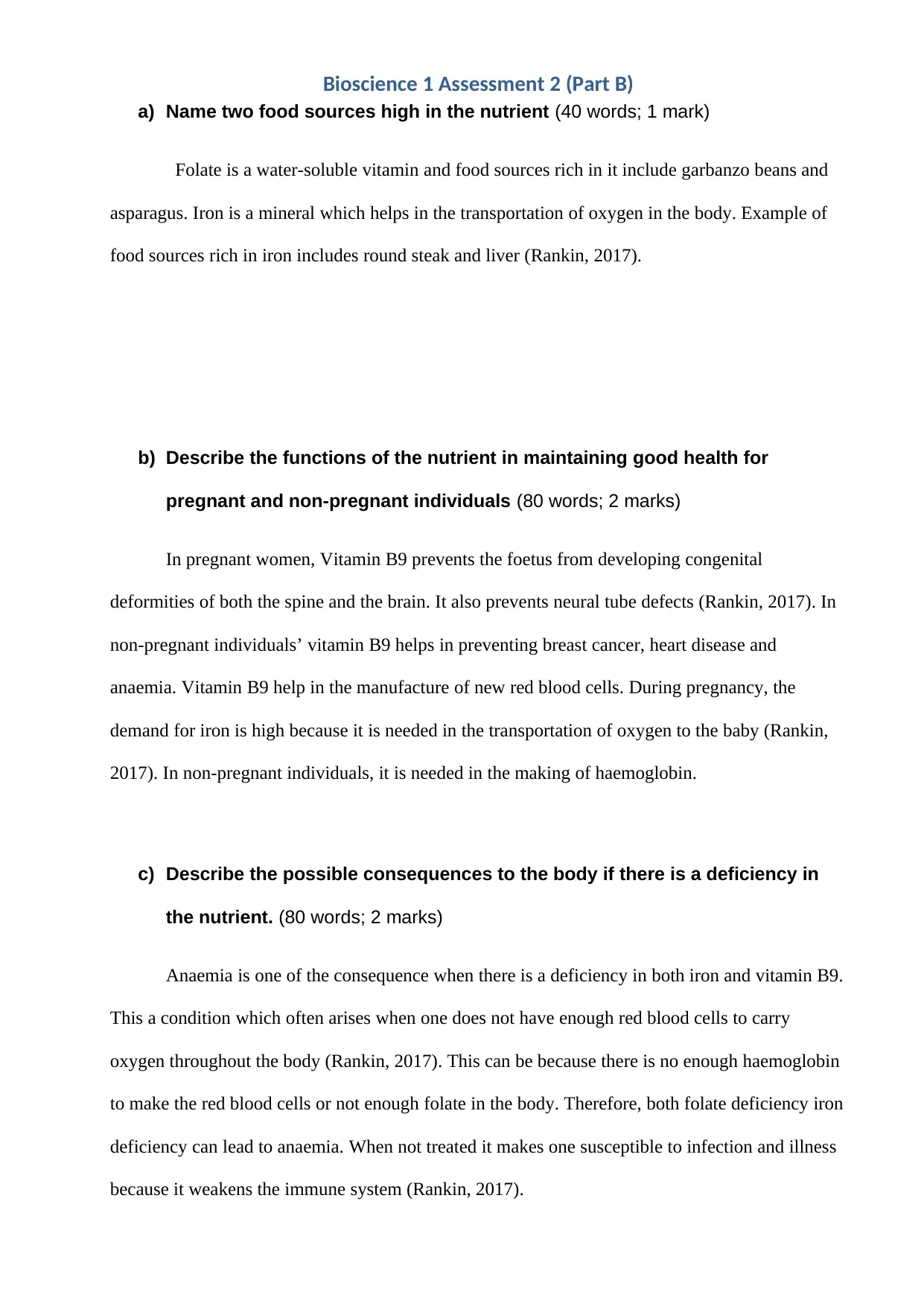
Bioscience 1 Assessment 2 (Part B)
a) Name two food sources high in the nutrient (40 words; 1 mark)
Folate is a water-soluble vitamin and food sources rich in it include garbanzo beans and
asparagus. Iron is a mineral which helps in the transportation of oxygen in the body. Example of
food sources rich in iron includes round steak and liver (Rankin, 2017).
b) Describe the functions of the nutrient in maintaining good health for
pregnant and non-pregnant individuals (80 words; 2 marks)
In pregnant women, Vitamin B9 prevents the foetus from developing congenital
deformities of both the spine and the brain. It also prevents neural tube defects (Rankin, 2017). In
non-pregnant individuals’ vitamin B9 helps in preventing breast cancer, heart disease and
anaemia. Vitamin B9 help in the manufacture of new red blood cells. During pregnancy, the
demand for iron is high because it is needed in the transportation of oxygen to the baby (Rankin,
2017). In non-pregnant individuals, it is needed in the making of haemoglobin.
c) Describe the possible consequences to the body if there is a deficiency in
the nutrient. (80 words; 2 marks)
Anaemia is one of the consequence when there is a deficiency in both iron and vitamin B9.
This a condition which often arises when one does not have enough red blood cells to carry
oxygen throughout the body (Rankin, 2017). This can be because there is no enough haemoglobin
to make the red blood cells or not enough folate in the body. Therefore, both folate deficiency iron
deficiency can lead to anaemia. When not treated it makes one susceptible to infection and illness
because it weakens the immune system (Rankin, 2017).
a) Name two food sources high in the nutrient (40 words; 1 mark)
Folate is a water-soluble vitamin and food sources rich in it include garbanzo beans and
asparagus. Iron is a mineral which helps in the transportation of oxygen in the body. Example of
food sources rich in iron includes round steak and liver (Rankin, 2017).
b) Describe the functions of the nutrient in maintaining good health for
pregnant and non-pregnant individuals (80 words; 2 marks)
In pregnant women, Vitamin B9 prevents the foetus from developing congenital
deformities of both the spine and the brain. It also prevents neural tube defects (Rankin, 2017). In
non-pregnant individuals’ vitamin B9 helps in preventing breast cancer, heart disease and
anaemia. Vitamin B9 help in the manufacture of new red blood cells. During pregnancy, the
demand for iron is high because it is needed in the transportation of oxygen to the baby (Rankin,
2017). In non-pregnant individuals, it is needed in the making of haemoglobin.
c) Describe the possible consequences to the body if there is a deficiency in
the nutrient. (80 words; 2 marks)
Anaemia is one of the consequence when there is a deficiency in both iron and vitamin B9.
This a condition which often arises when one does not have enough red blood cells to carry
oxygen throughout the body (Rankin, 2017). This can be because there is no enough haemoglobin
to make the red blood cells or not enough folate in the body. Therefore, both folate deficiency iron
deficiency can lead to anaemia. When not treated it makes one susceptible to infection and illness
because it weakens the immune system (Rankin, 2017).

Bioscience 1 Assessment 2 (Part B)
⊘ This is a preview!⊘
Do you want full access?
Subscribe today to unlock all pages.

Trusted by 1+ million students worldwide
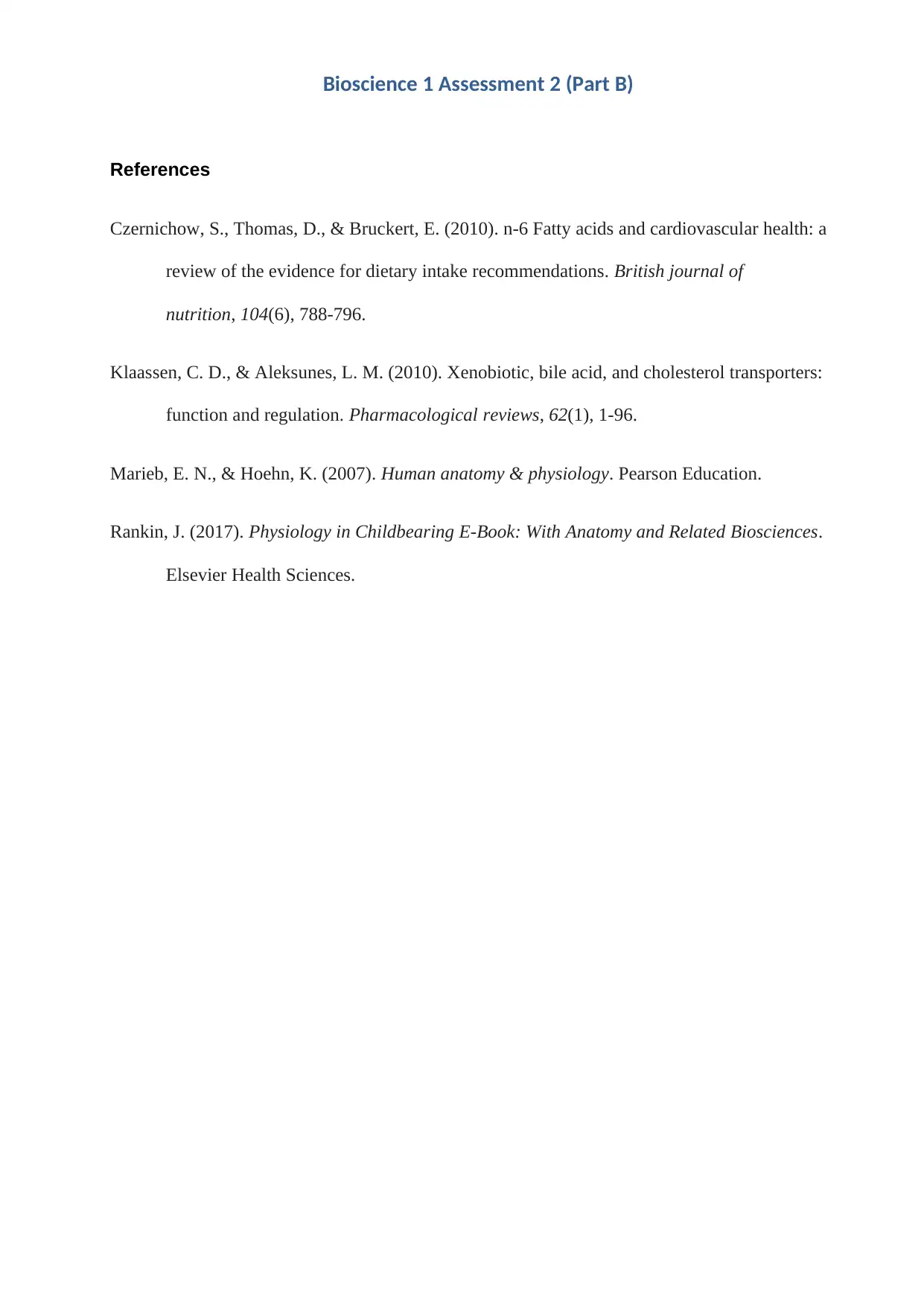
Bioscience 1 Assessment 2 (Part B)
References
Czernichow, S., Thomas, D., & Bruckert, E. (2010). n-6 Fatty acids and cardiovascular health: a
review of the evidence for dietary intake recommendations. British journal of
nutrition, 104(6), 788-796.
Klaassen, C. D., & Aleksunes, L. M. (2010). Xenobiotic, bile acid, and cholesterol transporters:
function and regulation. Pharmacological reviews, 62(1), 1-96.
Marieb, E. N., & Hoehn, K. (2007). Human anatomy & physiology. Pearson Education.
Rankin, J. (2017). Physiology in Childbearing E-Book: With Anatomy and Related Biosciences.
Elsevier Health Sciences.
References
Czernichow, S., Thomas, D., & Bruckert, E. (2010). n-6 Fatty acids and cardiovascular health: a
review of the evidence for dietary intake recommendations. British journal of
nutrition, 104(6), 788-796.
Klaassen, C. D., & Aleksunes, L. M. (2010). Xenobiotic, bile acid, and cholesterol transporters:
function and regulation. Pharmacological reviews, 62(1), 1-96.
Marieb, E. N., & Hoehn, K. (2007). Human anatomy & physiology. Pearson Education.
Rankin, J. (2017). Physiology in Childbearing E-Book: With Anatomy and Related Biosciences.
Elsevier Health Sciences.
1 out of 7
Related Documents
Your All-in-One AI-Powered Toolkit for Academic Success.
+13062052269
info@desklib.com
Available 24*7 on WhatsApp / Email
![[object Object]](/_next/static/media/star-bottom.7253800d.svg)
Unlock your academic potential
Copyright © 2020–2025 A2Z Services. All Rights Reserved. Developed and managed by ZUCOL.





